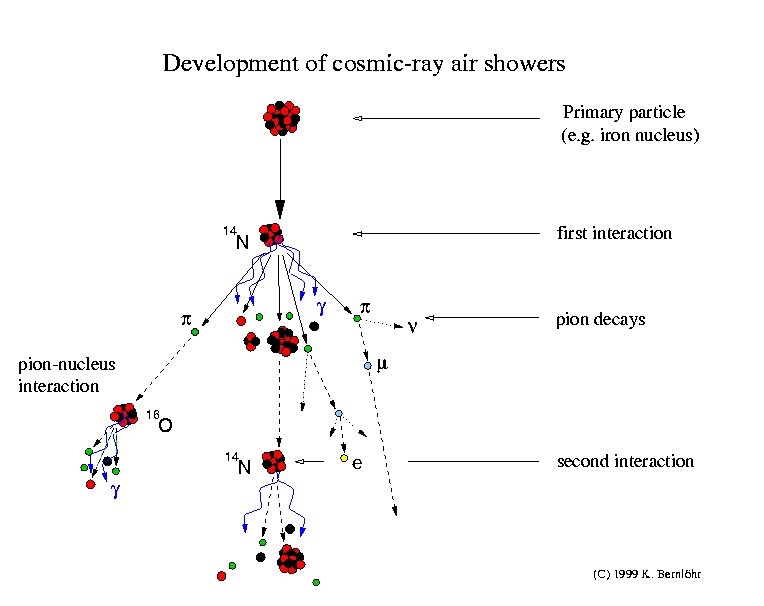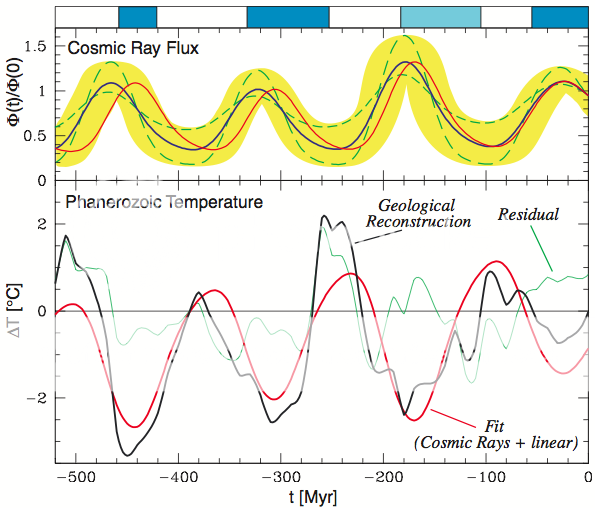Galactic cosmic rays: Backing the wrong horse
Posted on 24 September 2011 by muoncounter
The popular press is still pushing the preliminary CERN CLOUD results as proof that galactic cosmic rays (GCRs) are a major influence on climate. We've already had an excellent rebuttal here on SkS, featuring Jasper Kirkby's own words urging a more sober interpretation of his preliminary results. Yet those who do not fully understand the science are willing to bet that they have proof positive of the GCR-climate connection. Here is another look at the science of cosmic rays, in which we find out that's not a very good bet.
In horse racing, there's a payout for the 1st, 2nd and 3rd place finishers. All the other horses in the race finish 'out of the money.' One way to go broke very quickly is to repeatedly back the wrong horse.
Let's Check the Odds
The GCR-climate connection is based on well known science: cosmic rays do indeed contribute to ionization of the earth's atmosphere (known as CRII, for cosmic ray induced ionization). Whether CRII leads to enhanced cloud formation is the basic conjecture that GCR supporters want to establish. They must then show that GCR-induced clouds (if any such exist) in turn produce observable climatic effects.
If this is to be a horse a race, we must examine the field of entrants and study their track records. The full family of particles observed when an energetic primary GCR particle enters the atmosphere is illustrated below.

-- source
The CERN CLOUD experiment uses a positive pion beam of 3.5 GeV energy, a relatively middle-of-the-road energy on the spectrum of GCRs. Thus CLOUD backs only one horse in this race: the right-most interaction, pions (π) decay to muons (µ) and neutrinos (ν); note that this interaction does not produce neutrons and is thus invisible to neutron monitors around the world. What of all the other particle interactions on the diagram above? Which horse is the favorite in this race?
Picking a Favorite
Cosmic ray particles sourced by the sun are known as Solar Energetic Particles (SEPs) -- these are typically fast-moving solar wind protons. The energy associated with SEPs runs as high as 5 GeV, equivalent to a flux of 3x10-6 to 2x10-5 W/m2. Those on the lower end tend to penetrate only the upper atmosphere; these are the events that can lead to Forbush Decreases (FDs). Even higher energy SEPs can lead to significant increases in particle count rates at the earth's surface known as Ground Level Enhancements (GLEs). These events produce the additional particles shown in the illustration above; we do indeed see these events on neutron monitors.
The image below is a composite of neutron monitor records, illustrating the distinction between the appearance of FDs and GLEs. FDs have been observed as precursors to GLEs. In this example, the count rate multiple is approximately 25%, so the GLE is not particularly energetic.

-- source
Usoskin et al 2009 investigated ionization by GLEs (emphasis added):
"There is a strong correlation between the GLE magnitude (in Neutron Monitor %) and the ionization effect in the stratosphere ... – all strong GLEs led to a more than 10% enhancement of CRII in the polar region. There is still some weak relation in the upper troposphere ... – all strong GLEs lead to a slight positive ionization effect. ...
SEP play a role in the ionization only in the upper-middle polar atmosphere. In all other regions the ionization is suppressed due to the accompanying Forbush decrease. ... There is no ionization effect at mid- or low-latitudes, even for the strongest events. It is clear ... that there is no straightforward relation between the strength of GLE (as measured by neutron monitors) and the ionization effect in polar atmosphere. The net atmospheric ionization effect is defined by an interplay between the SEP event itself and a Forbush decrease, which often accompanies it."
That last statement is key to understanding just how  difficult it is to establish a cosmic ray-climate connection: Not all cosmic ray increases ionize the atmosphere. This horse race went from a walk in the park to a long, slow steeplechase on a very muddy field.
difficult it is to establish a cosmic ray-climate connection: Not all cosmic ray increases ionize the atmosphere. This horse race went from a walk in the park to a long, slow steeplechase on a very muddy field.
Jumping the Ionization Hurdle
Many GLEs originate as X-class solar flares and are thus relatively rare. The neutron monitor at Oulu, Finland observed 55 GLEs during the 50 year period 1960-2010. The neutron count rate increased by more than 10% in only 21 of these recorded GLEs. One of the largest occurred on 20 Jan 2005, as reported by a number of authors. From Bieber et al 2005,
"Within a 6-minute span on January 20, 2005, the count rate registered by a neutron monitor at the sea level station of McMurdo, Antarctica increased by a factor of 30, while the rate at the high-altitude (2820 m) site of South Pole increased by a factor of 56."
Inuvik and Fort Smith, Canada reported count rate multiples of 4-5; at Oulu the increase was 269%. High multiples of the background count rate persisted for several hours. Per Moraal et al 2008, the protons in this GLE contained a spectrum of energies from ~1.5 - 5 GeV; they also reported that the GLE was composed of at least 3 distinct pulses of particles arriving at the surface of the earth (the first of which caused a Forbush Decrease). Mironova et al 2011 looked at ionization due to this GLE (emphasis added):
"The very high level of neutron monitor count rate increase implies that the ionization of the polar atmosphere was dramatically increased during the event ... the calculated ionization due to the SEP event of 20 January started dominating over the GCR ionization already at 10-km altitude and reached its maximum at about 30 km altitude. In particular, the CRAC:CRII model calculations suggest that the SEP event produced additional ionization in the polar atmosphere in the altitude range 12–23 km, with the number of ions being greater by a factor of 3–30 than the averaged GCR-induced daily ionization in January 2005."
Mironova also looked for atmospheric effects due to this GLE (emphasis added):
"We would like also to emphasize that the observed atmospheric effect for this extreme GLE event was barely significant. No clear atmospheric effect was found beyond statistical fluctuations for the weaker SEP event of 17 January 2005, which is a typical SEP event. This implies that only extremely hard-spectrum (high energy) GLE/SEP events can produce a noticeable direct effect on aerosols in the polar low-middle stratosphere."
Thus one of the strongest known GLEs, producing much more ionization than the typical GCR, had no direct affect on the weather - and the sum of many such events will have no connection to climate.
In this horse race, until the CLOUD experiment can cl ear the ionization hurdle by investigating the complex relationship between FDs and higher energy GLEs, it will continue to be tripped by this hurdle and always finish out of the money. Those who've put their money on CERN CLOUD finding a GCR-climate connection are backing the wrong horse.
ear the ionization hurdle by investigating the complex relationship between FDs and higher energy GLEs, it will continue to be tripped by this hurdle and always finish out of the money. Those who've put their money on CERN CLOUD finding a GCR-climate connection are backing the wrong horse.
Note: Revised 9/24/2011































 Arguments
Arguments






























[DB] Inflammatory deleted. Please refresh yourself with the Comments Policy and ensure that future comments fully comply with it.
Here is the GCR over 100's of millions of years from Shaviv http://www.blc.arizona.edu/courses/schaffer/182h/Climate/CelestialDriver.pdf:
